Buenos Aires is a veritable concrete jungle.
Just take a look at the endless urban sprawl as you fly in, it’s massive.
So it’s only a matter of time before you’re itching for a little grass between your toes, a little fresh air, and room to move.
Luckily, there are some gorgeous parks in Buenos Aires.
These green spaces are like the lungs of the city, breathing fresh air into a city filled with weaving streets, buses, and traffic.

QUICK NOTE: This post contains affiliate links and Sol Salute may receive a commission for purchases made through these links, at no extra cost to you.
The 9 Best Parks in Buenos AIres
If you’re looking for a park to run, have a picnic, or a mate like a local, then this post is here to help.
Here are the best Buenos Aires parks to escape to when you need a little nature break in the midst of the big, big city.
At the end of this post there’s a map with all these parks plotted out on it to help you plan your day in the park!
Los Bosques de Palermo
The most popular Buenos Aires park is without a doubt Los Bosques de Palermo, officially named El Parque 3 de Febrero.
It’s the Central Park of Buenos Aires and is a major meeting point for locals of all ages on sunny days.

This massive park has been around since the end of the 19th century. In 1852, Sarmiento overthrew strongman dictator Juan Manuel de Rosas.
His lands on the northern edge of the city were converted into the Palermo parks you see today.
The official (but rarely used) name 3 de Febrero comes from the date he was defeated.
At the turn of the 20th Century, Carlos Thay was commissioned to better design, expand and beautify the park.
His name will be familiar to you by the end of this post.
He’s responsible for more than a couple beautiful Buenos Aires parks.

What to do in Bosque de Palermo
There is no lack for uniquely Buenos Aires things to do here.
There are kilometers of trails to run, bike or skate.
Have a picnic or join one of the city-run exercise classes that take place on the weekend.
Here are some of the highlights:
- Rosedal | The most beautiful area of this park is the rose garden, El Rosedal (photo above). 93 different species of rose are grown over 4 hectares. It’s gorgeous and a must-see.
- Rent a paddle boat | There are three artificial lakes in the park and renting a paddle boat is a great way to spend an afternoon!
- The Planetarium | Traveling with kids? The Planetarium is a great way to entertain them for an afternoon. Check hours and get your tickets online here.
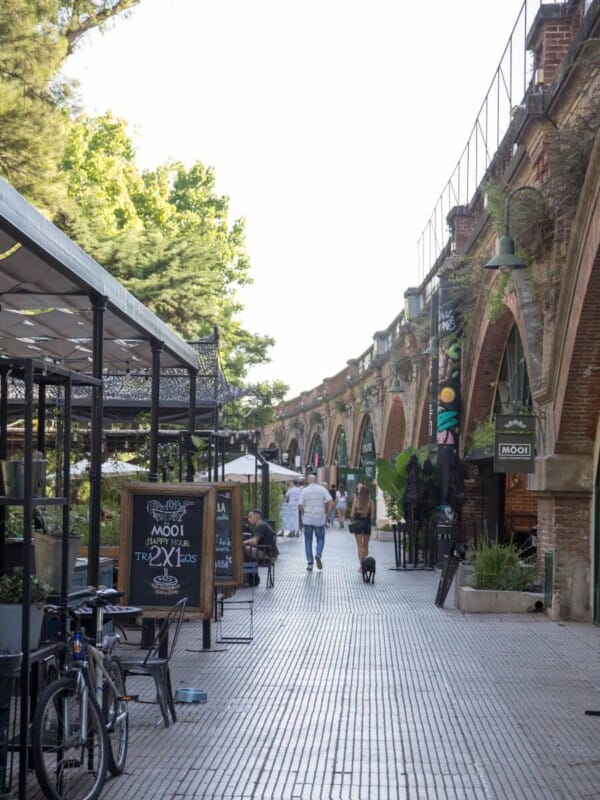
- Eat a choripan | Or a lomito (steak sandwich) from the food trucks! This is the most classic way to picnic in the Bosques, it’s also not a light meal so maybe go for a stroll afterward to digest all that delicious meat.
- Eat at the Arcos del Rosedal | There’s a new gastronomic hot spot at the northern edge of the park built in the arches below the train tracks. There are amazing restaurants setting up shop here and it’s great even at night for happy hour or drinks or a weekend brunch.
El Jardín Japonés
The Japanese Gardens in Buenos Aires aren’t far from the Bosques de Palermo, actually occupying 5 acres on the northeast corner.
The Jardín Japonés is one of the largest gardens of its kind outside of Japan. It’s home to a both native Japanese flora as well as complimentary South American plant species.
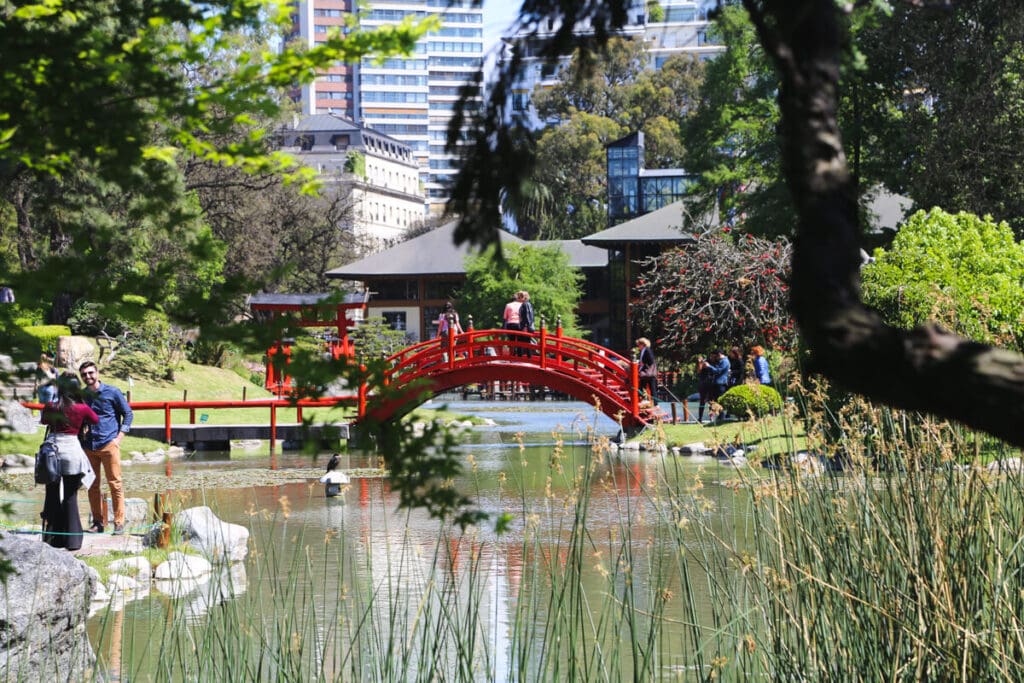
It’s not free to visit but the price is very affordable at $200 pesos (as of February 2020), but is free for children under 12 and people over 65.
Opening hours are from 10 am to 6 pm. Check the official site for more information.
Relax as you walk down the path or bring a book and stay awhile.
There is also a restaurant within the gardens where you can immerse yourself in Japanese culture and try traditional Japanese cuisine.
What to do nearby the Japanese Gardens?
- Nearby museums: The MALBA (Museum of Latin American Art) and the Museo Nacional de Arte Decorativo are two excellent museums nearby to continue your day filled with culture.
- Have a glass of wine at Casa Cavia (Cavia 2985): This super stylish bar is only a few blocks away and has a gorgeous interior patio, ideal for a glass of wine or a coffee after the Japanese gardens.
Jardín Botánico: Buenos Aires’ Botanical Gardens
Buenos Aires’ Jardín Botánico is located in the heart of Palermo.
Entrance is free of charge and there’s only one access point, at Santa Fe Av. 3951.
For a full list of activities and opening hours check here.
This ultimate green space was designed in 1898 by Carlos Thays, arguably the most important landscape architect in Argentina.

Thays designed most of the important Buenos Aires parks and green spaces, including the Bosques de Palermo mentioned earlier.
These botanical gardens cover just over 17 acres of land and are the best place in the city to experience Argentina’s native flora.
You can see everything from yerba mate trees to palms and even an impressive herb garden.
It’s also a popular escape for locals looking for a place to rest their feet or drink mate with friends.
It’s easy to see why. It’s so peaceful inside these gardens that it’s easy to forget you’re actually only steps from Plaza Italia, one of the city’s most bustling transportation hubs.
What to do nearby the Jardín Botánico?
- Explore the neighboring parks. You’re not far from the Bosques de Palermo and you’re only steps from the next park on this list: the Eco-Park.
- When you leave, cross Santa Fe and explore Palermo Soho, the city’s hippest neighborhood filled with cafes, bars, and boutique shopping.
The Buenos Aires Eco-park
Just steps from the botanical gardens is the Buenos Aires Eco-Park. You can enter the park in Plaza Italia and entrance is free.
This brand new park was once home to the saddest zoo there ever was.
In 2016, finally listening to outcries over the zoo’s cruelty, the city closed down the 140 year old zoo and relocated 2,500 of the inhabitants to much more ethical sanctuaries and nature reserves.
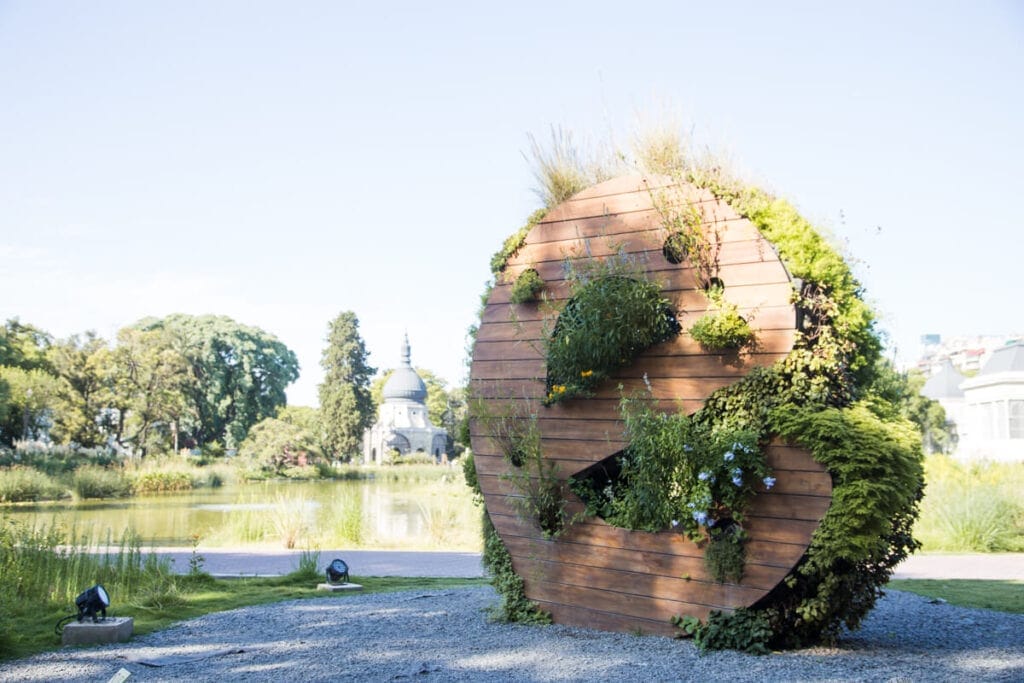
Animals that were too old or sick to be moved remain but with a much better quality of life.
There are also native species still on display here, like maras (similar to hare) and peacocks that roam freely.
The goal is that no animal here remain permanently in captivity.
The Eco-Park focuses on rehabilitating injured animals or those found in illegal trafficking situations and releasing them back into the wild. There is even a clinic on site.
What to do near the Eco Park?
Visit the other Buenos Aires parks!
-
Start at the Botanical Gardens, then make your way through the Eco-Park. Enter in Plaza Italia and walk through the park towards the Libertador Avenue exit. This will leave you right in front of the Bosques de Palermo.
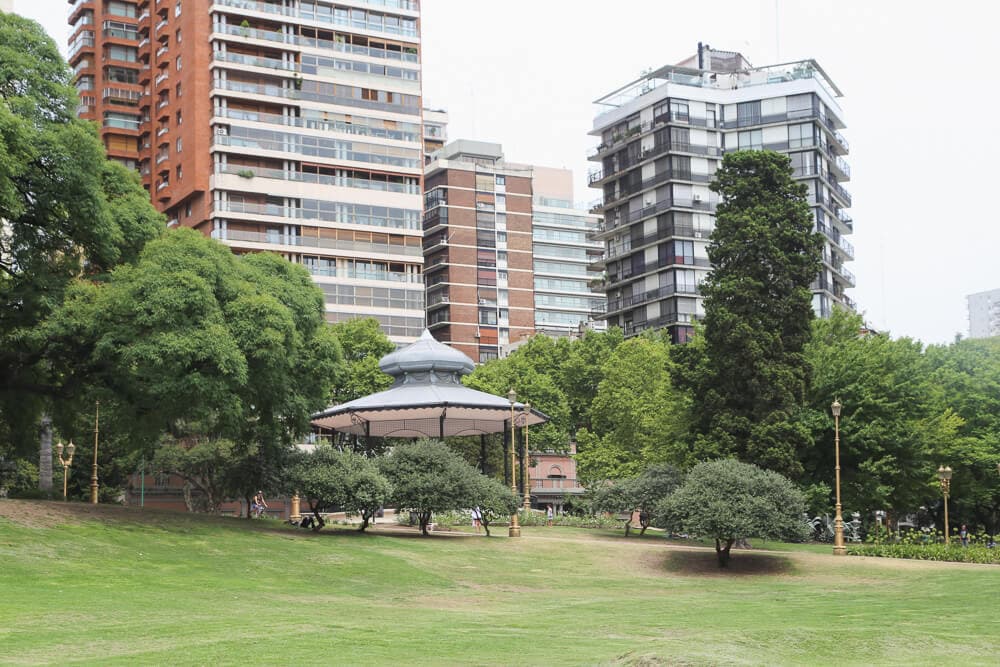
Barrancas de Belgrano
The first four parks were all in Palermo, so it’s time to branch out!
This beautiful park is in the more residential neighborhood towards the north of the city, Belgrano.
The Barrancas de Belgrano are located in front of Chinatown and the Belgrano C train station.
The sloping hill (or barrancas) was converted into a park by Carlos Thays in 1892.
Hidden away near the La Pampa border of the park is a small version of the Statue of Liberty.
An original by the same artist that created her big sister in New York.

On the opposite corner of the barrancas is La Glorieta, a large gazebo.
Every evening local tango aficionados gather here to dance under the stars in one of the most popular milongas in the city.
If you want to learn to dance there are tango classes Mon-Fri at 7 pm, with the actual milonga and the pros hitting the floor at 8 pm.
On the weekend, the class begins at 5 pm, and the milonga at 7 pm. This is an excellent way to learn tango (or simple watch in awe).
What to do near the Barrancas del Belgrano?
- Tango! As described above, the nightly milonga is one of the best things to do here.
- Visit Chinatown, just across the street is Barrio Chino, Buenos Aires’ small but worthwhile Chinatown.
Parque LEzama
Parque Lezama is in the southern barrio of San Telmo.
Prior to the 18th-century yellow fever epidemic, the southern portion of the city was the wealthiest and this park was actually the private garden belonging to the Lezama family.
Today it’s a public park, free of charge and open 24 hours a day.
There are pathways to ramble and benches to rest your weary feet.
Be sure to check out the Russian Orthodox Cathedral on the border of the park at Avenida Brasil 315. It’s one of only 2 of its kind in the city. You can’t miss the royal blue domes and stunning facade.
What to do near Parque Lezama?
- Explore the rest of San Telmo, try to visit on a Sunday to experience the San Telmo Market.
- Puerto Madero, you’re not far from Puerto Madero. Walk a few blocks and visit Buenos Aires’ youngest neighborhood and the beautiful Puente de la Mujer (a tango-inspired modern bridge).
The Reserva Ecológica Costanera Sur
The Ecological Reserve is just behind Puerto Madero and covers an impressive 3.5 square kilometers of land on the Rio de la Plata shore.
While some of the parks on this list are great to rest, meet friends, or pause for a quick yerba mate, you could easily spend an entire day or afternoon in the Reserve Ecologica.
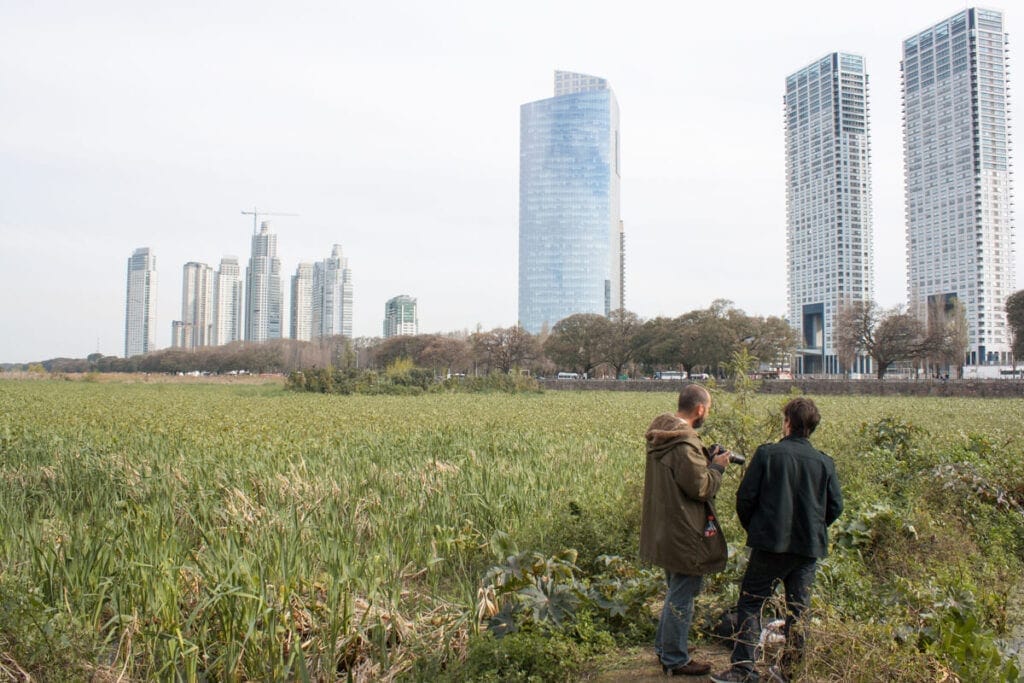
On a beautiful weekend, bring your bike to ride the many trails and a picnic lunch to eat by the water.
If you’re into nature, bring your best travel binoculars and go bird watching.
Many native species have settled here in the grasslands and ponds throughout the reserve.
This is the best park in Buenos Aires to escape to if you desperately need a break from the city.
When you’re on a jog, bike ride or walk here, you quickly forget about the bustling city behind you.
What to do nearby the Ecological Reserve?
- Nothing, relax and enjoy the whole day here!
- Have a choripan, the food trucks along the Costanera Sur promenade serve up some of the city’s greasiest and most popular choripan and lomitos (beef sandwiches).
- Visit San Telmo and Puerto Madero nearby.
Map of the Best Buenos Aires Parks
Looking for the best green space, plaza, or Buenos Aires park near you? Check out this Google Map plotting out all of the parks mentioned in this post.
Honorable Mention Parks in Buenos Aires
The previous parks on this list are the show-stoppers, the Carlos Thays designed masterpieces, the rose gardens, and massive reserves. Here are a couple “honorable mention” parks.
These two parks are a bit off the beaten tourist path but remain equally popular among the local residents looking for a patch of green in the middle of this concrete jungle we live in.
- Parque Centenario | Caballito | This large park is in the geographic center of the city in the residential neighborhood of Caballito. Go for a jog, shop in the weekend market, or bring your mate and a blanket to relax in the afternoon.
- Parque Saavedra | Saavedra | On the northern border of the city in Saavedra, this oval-shaped park holds a special place in my heart. It’s where I lived for quite a few years and where my husband grew up! The blocks surrounding this park are quickly being renovated, one by one, with new restaurants and bars opening up all the time. Keep your eye on this barrio folks.
Pin It For Later
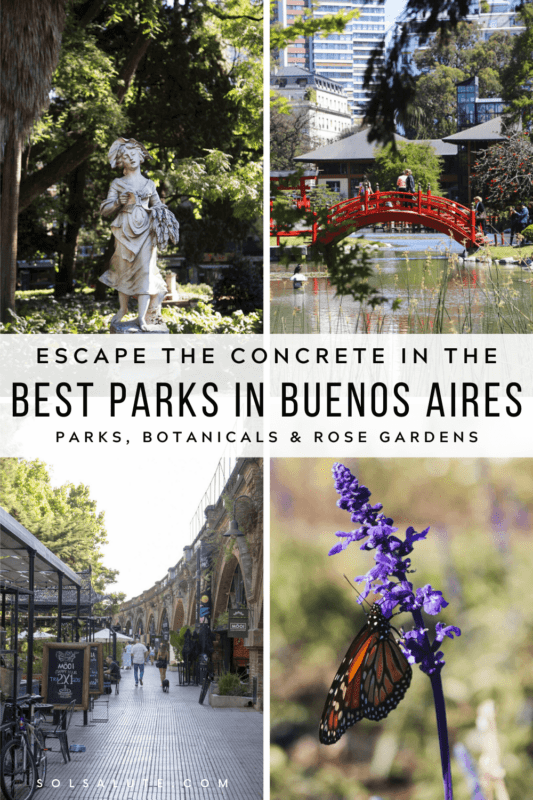
Argentina Travel Resources
- BOOK A CONSULTATION | I offer one-on-one travel consultations to help you plan your trip to Argentina. Pick my brain to get a local’s insight. Click here for more information.
- MY MAP | Buy my interactive map with 300+ pins to have access to the city as I see it. It is an invaluable resource. See more here about how it works.
- AIRPORT TRANSFERS | Having a driver waiting for you is ideal for a stress free arrival, Cesar and his team here is the best option for a driver from Ezeiza or Aeroparque, they are my go-to airport ride!
- TRAVEL INSURANCE | Always travel insured. Anything can happen anywhere and it is scarier and costlier in an unfamiliar country. SafetyWing’s Essential Plan covers unexpected travel and medical emergencies and even offers add-ons like electronics theft or adventure sports. It is the best if you’re coming on vacation. If you’re coming as a digital nomad or an extended stay, you need their Complete Nomad Plan which also covers routine check ups, maternity, mental healthcare and more. Read more: Health Insurance in Argentina
- PHONE PLAN | These days, traveling with data is essential. Especially in Argentina where everything is managed on Instagram and WhatsApp. I recommend this E-SIM card. It’s hassle-free and affordable, for more read how to get an Argentina sim card.
- ACCOMMODATION IN ARGENTINA | booking.com is the most common hotel site used in Argentina and it’s where you’ll find the most options.
- RENTAL CARS | I love using Discover Cars, it is a great platform to compare different rates and providers and I find they have responsive customer service.
- BUS TICKETS | Check Busbud for long distance bus routes and tickets.
- VPN | If you’ll be using a public WiFi connection and want to secure your data, I highly recommend using a VPN, I personally use and have had a good experience with ExpressVPN. I also use it to access Hulu and American Netflix from Argentina.
- FLIGHTS | Always check Google Flights and Skyscanner for flights to and within Argentina. Aerolineas Argentina is the local airline with the most routes. FlyBondi and Jetsmart are two budget airlines with dirt-cheap prices (but expect to pay for every add-on like luggage).

